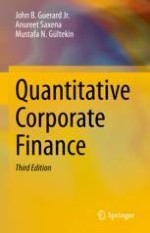2022 | OriginalPaper | Buchkapitel
11. Investing in Assets: Theory of Investment Decision-Making
verfasst von : John B. Guerard Jr., Anureet Saxena, Mustafa N. Gültekin
Erschienen in: Quantitative Corporate Finance
Aktivieren Sie unsere intelligente Suche, um passende Fachinhalte oder Patente zu finden.
Wählen Sie Textabschnitte aus um mit Künstlicher Intelligenz passenden Patente zu finden. powered by
Markieren Sie Textabschnitte, um KI-gestützt weitere passende Inhalte zu finden. powered by
